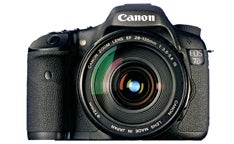Hands On: Canon EOS 7D
This 18MP DSLR takes aim at Nikon's D300S with its new AF system.

We may earn revenue from the products available on this page and participate in affiliate programs. Learn more ›
Trying Canon’s new EOS 7D ($1,700, street, body only; $1,900 with 28-135mm f/3.5-5.6 Canon EF-S IS lens) in a preproduction version, I could see that the DSLR wars are escalating again. Not that the conflict hasn’t been ongoing-Nikon has targeted Canon head-on with its innovative and powerful DSLRs, plus key reinforcements to its lens line. But with the 7D, Canon is taking aim directly at Nikon’s new D300s.
The 7D boasts an 18MP CMOS sensor-we expect it to produce the highest resolution from an APS-C-sensor camera-and a burst rate of 8 frames per second . Plus, it has new autofocus and metering systems that, similar to the Nikon’s, work together to track a moving subject.
These come in a rugged, weather-resistant body that’s slightly larger than the EOS 50D , one notch below it in Canon’s line. Raise the 7D to your eye and you’re greeted with a nice big view-Canon lists viewfinder magnification at 1X with 100% accuracy, unusual at this price. We’ll test that claim, and the 7D’s actual performance, when we get a full production model.
But after a few days using a prototype, I learned a lot.
AF And Meter Overhaul
The autofocus system is a huge step forward for Canon. It has 19 cross-type sensors, with a high-precision, dual-diagonal central one that detects detail at any orientation and is especially accurate with fast, f/2.8 lenses.
You can select AF points grouped into zones-handy in continuous AF mode when you know where the subject will enter the frame. Photographing a running dog, for instance, I was able to lock on faster by limiting the AF zone than by using the 19-point auto AF mode.
Switching among zones was fast: Press a button on the back with your thumb, then push the joystick toward the zone you want. And you can set it to automatically shift to an equivalent point or zone whenever you reorient the camera.
The meter helps AF track by color, a first for Canon. It uses a 63-zone dual-layer system in which one layer detects blues and reds, and the other greens and blues. Canon says this provides more accurate exposures- previous metering systems could be overly sensitive to reds.
The 7D’s magnesium-alloy chassis helps make the body durable while keeping its weight below 2 pounds.
New High-Res Sensor
The sensor’s additional (and small) pixels seem to make for noise. With about 50% more pixels than the Nikon D300s, the 7D should deliver more resolution, but in the images I shot with an early unit, noise was quite noticeable at ISO 6400 and even more so at the top sensitivity of ISO 12,800. That may be corrected in the final release version.
Video? The most options for resolution and frame-rate of any DSLR. Full 1920×1080-pixel HD recording at 30 frames per second will match your HDTV’s frame rate; 24 fps will please cineasts. Step down to 1280×720 and choose from 60, 30, or 24 fps. A mono mic is built in; a jack accepts a stereo mic. No continuous AF, but a button lets you switch focus to a new subject.
Controls And Handling
The image stabilization system is in the lens, not the body.
Menus are easier to use than on Canon’s other high-end DSLRs. Following the trend set by Olympus, a Quick Control menu gives speedy access to key settings. Press the Q button, and the LCD becomes a control panel you can navigate with the joystick.
The 7D handles like a dream- comfortable to hold and easy to operate. And a new dual-axis electronic level senses both roll and pitch, making capturing perfect horizons a breeze.
What needs improvement? Live view-AF relies on a sluggish contrast system, unless you flip the mirror to focus, then flip it back to frame your shot. (Camera makers should learn from Sony, with its second imaging sensor.)
It looks like the smaller-format DSLR battle will be as exciting as the full-frame fight.